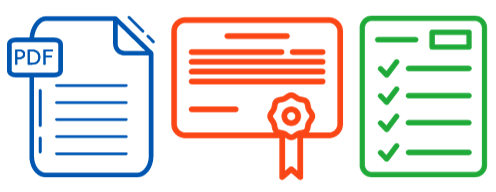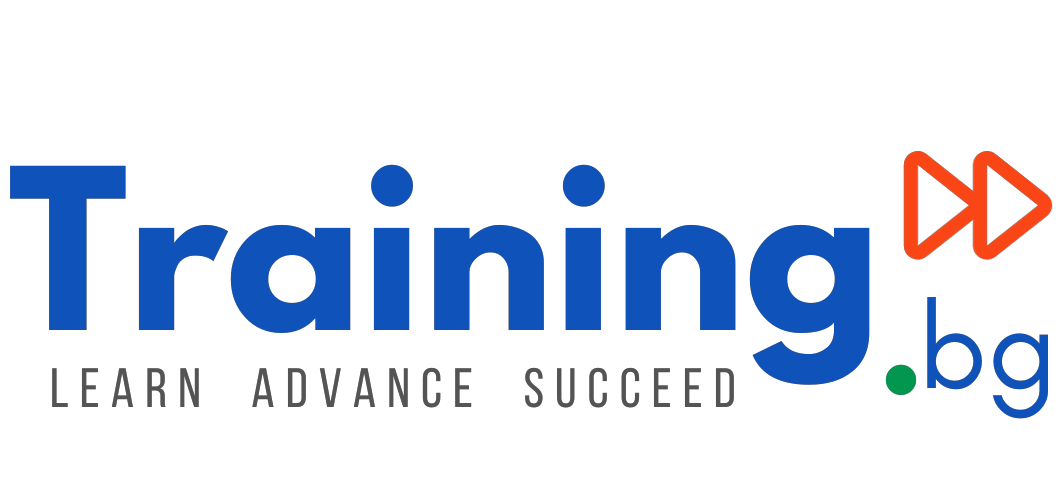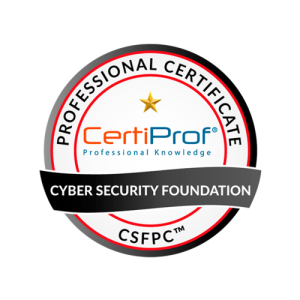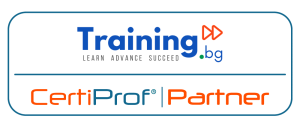Cyber Security Foundation Professional Certificate CSFPC™
- Код:CSFPC
В наличност
Прилагането на ефективни мерки за киберсигурност е особено предизвикателство днес, защото вече има повече устройства, отколкото хора, а нападателите стават все по-иновативни.
Със завършшване на сертификационната програма Cyber Security Foundation Professional Certificate CSFPC™ ще разберете техниките за защита на личната информация, включително комуникации, приложения и изводи от бази данни и обработка на данни. Ще се запознаете и с други системи, поддържащи онлайн права, засягащи цензурата, тайната, електронните избори и поверителността в системите за плащане и идентификация.
Бърза поръчка без регистрация
(Само попълнете 3 полета)Тази сертификационна програма е част от портфолиото на CertiProf® (САЩ) - водеща организация за професионално сертифициране, с над 800 000 сертифицирани професионалисти от 88 държави и повече от 1,1 милиона дигитални баджа, издадени чрез Credly.
CertiProf® е член на ANSI (American National Standards Institute), Agile Alliance и IT Certification Council (ITCC).
CertiProf® предлага програмата Cyber Security Foundation Professional Certificate CSFPC™ за валидиране на вашите знания по основи на киберсигурността. Изпитът представлява онлайн тест с възможни отговори и можете да го направите през Вашия личен компютър от всяка точка на света.
С преминаване на сертификационната програма Cyber Security Foundation Professional Certificate CSFPC™ ще научите основните концепции на киберсигурността. Ще разберете техниките за защита на личната информация, включително комуникации, приложения и изводи от бази данни и обработка на данни. Ще се запознаете и с други системи, поддържащи онлайн права, засягащи цензурата, тайната, електронните избори и поверителността в системите за плащане и идентификация.
За кого е програмата Cyber Security Foundation Professional Certificate CSFPC™:
- Всички
- Крайни потребители
- Мениджъри

Какво ще получите, когато поръчате тази сертификационна програма:
- Богато илюстровани материали за подготовка в PDF
- Ваучер за онлайн изпит с право на 2 опита
- Сертификат и дигитален бадж на Credly при успешен изпит
Цели на програмата:
- Да разберете значението на киберсигурността
- Да се запознаете с ключовите понятия, свързани с киберсигурността
- Да разберете понятията, свързани с човешки, организационни и регулаторни аспекти
- Да се запознаете с концепциите, свързани със защитата от атаки
Формат и продължителност на изпита
- Формат: въпроси с възможни отговори
- Брой въпроси: 40
- Език: английски (свържете се с нас, ако желаете да държите изпита на испански, немски или португалски)
- Необходим брой верни отговори: 24/40 или 60%
- Продължителност: 60 минути
- Ползване на помощни материали: не
- Начин на провеждане: онлайн
- Право на безплатен втори изпит в рамките на 6 месеца от издаване на изпитния ваучер
Предварителни изисквания
Няма официални предварителни изисквания.

Съдържание на учебните материали
Module 0: NIST - Cybersecurity for Small Business
Cybersecurity for Small Business
Cybersecurity Objectives
Confidentiality
Integrity
Availability
Small Business, Big Impact
Cybersecurity Basics Resources
Cybersecurity Threats
Phishing Attacks
Ransomware
Hacking
Imposter Scams
Environmental Threats
Elements of Risk
Impact of an Incident
What are you protecting?
1. Identify Your Business Assets
2. Identify the Values of the Assets
3. Document the Impact to your Business of Loss/Damage to the Assets
4. Identify Likelihood of Loss or Damage to the Asset
5. Identify Priorities and Potential Solutions
NIST Cybersecurity Framework
Cybersecurity Framework Functions
Learning Objectives
The Framework Core
An Excerpt from the Framework Core
Identify
Sample Identify Activities
Protect
Sample Protect Activities
Detect
Sample Detect Activities
Respond
Sample Respond Activities
Recover
Sample Recover Activities
Framework
Everyday Tips
Module 1: CyBOK – Cyber Security Fundamentals
Cyber Security Definition
CyBOK Knowledge Areas
Deploying CyBOK Knowledge To Address Security Issues
Functions Within A Security Management System
Principles
Crosscutting Themes
Cyberspace
Module 2: Risk Management & Governance
What is Risk?
Why is risk assessment and management important?
What is cyber risk assessment and management?
Risk Governance
The Human Factor and Risk Communication
Security Culture and Awareness
Enacting Security Policy
Risk Assessment and Management Principles
Element of Risk
Risk Assessment and Management Methods
Component-driven Cyber Risk Management Frameworks
System-driven Cyber Risk Management Methods
Risk Assessment and Management In Cyber-physical Systems and Operational Technology
Security Metrics
What constitutes Good and Bad metrics?
Business Continuity
ISO/IEC 27035-1:2016
NCSC- ISO/IEC 27035
Module 3: Law and Regulation
Introduction
Challenges
Response
Out of Scope
Introductory Principles of Law and Legal Research
“To Prove” Something
“Standards” of Proofs
Applying Law to Cyberspace and Information Technologies
Distinguishing Criminal and Civil Law
Jurisdiction
A Taxonomy of Jurisdiction
Prescriptive Jurisdiction
Enforcement Jurisdiction
The Data Sovereignty Problem
Privacy Laws in General and Electronic Interception
State Interception (Lawful Access)
Non-state Interception
Data Protection
The “Players”
What is regulated?
“Personal Data” vs “PII”
Data Protection Highlights
Computer Crime
Crimes Against Information Systems
Recurring Challenges
Contract
Contract as Means to Encourage Security Behaviours
Limits of Influence
Relative Influence of Contract Over Security Behaviours
Breach of Contract & Remedies
Tort
Tort Examples
Negligence (Fault Based Liability)
Product Liability (Strict Liability)
Quantum of Loss (QQ)
Attributing and Apportioning Liability
Intellectual Property
Reverse Engineering
Internet Intermediaries Shields from Liability and Take-down Procedures
Dematerialization of Documents and Electronic Trust Services
Legal Challenges Emerge
Other Regulatory Matters
Public International Law
State Attribution
Limiting Operations
Ethics
Codes of Conduct
Vulnerability Testing and Disclosure
Legal Risk Management
Module 4: Human Factors
Human Factors
Security Has to be Usable
Fitting the Task to the Human
Human Capabilities and Limitations
STM and One-time password (OTPs)
General Human Capabilities and Limitations
CAPTCHA
Goals and Tasks
Capabilities and Limitations of the Device
Human Error
Latent Design Conditions
Awareness and Education
What usability issues do developers face?
Developers are not the Enemy! The Need for Usable Security APIs
Usability Smells: An Analysis of Developers’ Struggle With Crypto Libraries
Module 5: Privacy & Online Rights
Introduction
Overview
Privacy as Confidentiality
What is the problem?
What is privacy?
Defining Privacy
Privacy as…
Privacy as Transparency
Privacy as Control
Limits of Control and Transparency
Privacy as Confidentiality
Privacy Threat Landscape
Formal Approach to Inference Control
Privacy as Confidentiality
Data Confidentiality
Metadata Confidentiality
Privacy as Control
Privacy as Transparency
Privacy Technologies
Privacy Engineering
Privacy Evaluation
Module 6: Malware & Attack Technologies
Introduction
Malware
A Taxonomy of Malware
Malware Taxonomy: Dimensions
Taxonomy: Examples
Potentially Unwanted Programs (PUPs)
Malicious Activities by Malware
The Cyber Kill Chain
The Cyber Kill Chain Model
Underground Eco-system
Action Objectives
Malware Analysis
Acquiring Malware Data
Static Analysis
Other Analysis Techniques
Analysis Environments
Common Environments
Safety and Live-Environments
Anti-Analysis and Evasion Techniques
Malware Detection
Evasion and Countermeasures
Detection of Malware Attacks
ML-based Security Analytics
ML-based Malware Detection
Evasion of ML-based Malware Detection
Concept Drift
Malware Response
Disrupt Malware Operations
Attribution
Evasion and Countermeasures
Module 7: Adversarial Behaviour
Introduction
A Characterization of Adversaries
Interpersonal Offenders
Cyber-enabled Organized Criminals
Cyber-dependent Organized Criminals
Hacktivists
State Actors
The Elements of a Malicious Operation
Specialized Services
Human Services
Payment Methods
Models to Understand Malicious Operations
Attack Trees : Example of an Attack
Cyber Kill Chain
Environmental Criminology
Attack Attribution
Module 8: Security Operations & Incident Management
Introduction
What is it about?
Timeline and Scope
Overall MAPE-K loop
Components of MAPE-K Monitor-Analyse-Plan-Execute
Deployment of SOIM Technologies
Architectural Principles Typical Architecture
Intrusion Detection and Prevention Systems
MONITOR: Data sources
Network Data Sources: Possible Detections
Application Data Sources
System Data Sources
Syslog
Frequent Data Sources Issues
Analysis of Traces
From Event to Incident
Misuse Detection
Anomaly Detection
General Intrusion Detection Issues
Typical Architecture Security Information and Event Managementures
Data Collection in SIEMs
Alert Correlation
Mitigations and Countermeasures Tools and Techniques
Intelligence and Analytics
Incident Management Lifecycle
CERTIPROF® is a registered trademark of CertiProf, LLC in the United States and/or other countries.
| Файл | Информация |
|---|---|
 Brochure-CSFPC Brochure-CSFPC | [PDF, 747.53 KB] |
 Syllabus-CSFPC Syllabus-CSFPC | [PDF, 1.39 MB] |




